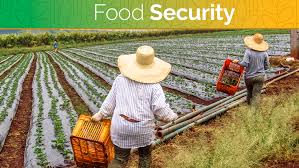The history of Nigeria’s agriculture is one of retrogression since the discovery of crude oil as the sector is still being sustained by peasant farmers, JOHN OBA reports.
One of the major sectors that gave Nigeria’s founding fathers the courage to fight for independence from the colonial master was the agriculture sector that was the main stay of the economy then.
History has it that Nigeria agriculture was second to none as countries across the world visited to learn about agriculture and some like Malaysia, Vietnam among others even took seeds from Nigeria to their countries to start up what is today yielding major income for them, but Nigeria they learn from abandoned this goldmine sector, because of crude dollars that seem to be a curse, as it has brought more problems to the country than blesswing.
Agriculture in post independent era
History has it that agriculture in Nigeria was so developed that policies were formulated in the post-independence era to actualize more equitable growth in agriculture. Export-led growth policies in the sector was developed which led to the demarcation of the country into the Western region which major on cocoa production, Northern region on groundnut and Eastern region on oil palm.
The 1962-1968 development plan was Nigeria’s first national plan. Among several objectives, it emphasized the introduction of more modern agricultural methods through farm settlements, cooperative, supply of improved farm implements like hydraulic hand presses for oil palm processing and a greatly expanded agricultural extension service.
Some of the specialized development schemes initiated or implemented during this period included: Farm Settlement Schemes; National Accelerated Food Production Programme (NAFPP) launched in 1972.There were also a number of agricultural development intervention experiments, notably are the Operation Feed the Nation, launched in 1976; River Basin and Rural Development Authorities, established in 1976; Green Revolution Programme, inaugurated in 1980; World Bank-funded Agricultural Development Projects (ADP).
While each of the above programmes sought to improve food production, the ADPs represented the major practical demonstration of the integrated approach to agricultural development in Nigeria, record has it.
Regrettably, the oil boom in the 1970s caused agriculture to assume a downward trend. Available data show that at independence in 1960, the contribution of agriculture to the GDP was about 60%, which is typical for developing agrarian nations. However, this share declined over time to only about 25% between 1975 and 1979. Between 1970 and 1982, agricultural production stagnated at less than one per cent annual growth rate, at a time when the population growth was between 2.5 to 3.0% per annum. There was a sharp decline in export crop production, while food production increased only marginally. Thus, domestic food supply had to be augmented through large imports. The food import bill rose from a mere N112.88 million annually during 1970 – 1974 to N1, 964.8 million in 1991 and then to billions of dollars in 2018. In 2018, food imports for Nigeria was 10.9 %. Though Nigeria food imports fluctuated substantially in recent years, it tended to decrease through 1996 – 2018 period ending at 10.9 % in 2018.
Agriculture in recent years
According to theFood and Agriculture Organisation (FAO) of the Union Nations report on Nigeria, in spite of the oil, agriculture remains the base of the Nigerian economy, providing the main source of livelihood for most Nigerians. The sector faces many challenges, notably an outdated land tenure system that constrains access to land (1.8 ha/farming household), a very low level of irrigation development (less than 1 percent of cropped land under irrigation), limited adoption of research findings and technologies, high cost of farm inputs, poor access to credit, inefficient fertilizer procurement and distribution, inadequate storage facilities and poor access to markets have all combined to keep agricultural productivity low (average of 1.2 metric tons of cereals/ha) with high postharvest losses and waste.
Even though agriculture still remains the largest sector of the Nigerian economy and employs two-thirds of the entire labour force, the production hurdles have significantly stifled the performance of the sector. Over the past 20 years, value-added per capita in agriculture has risen by less than 1 percent annually. It is estimated that Nigeria has lost USD 10 billion in annual export opportunity from groundnut, palm oil, cocoa and cotton alone due to continuous decline in the production of those commodities. Food (crop) production increases have not kept pace with population growth, resulting in rising food imports and declining levels of national food self-sufficiency (FMARD, 2008). The main factors undermining production include reliance on rainfed agriculture, smallholder land holding, and low productivity due to poor planting material, low fertilizer application, and a weak agricultural extension system amongst others.
Nigeria is the continent’s leading consumer of rice, one of the largest producers of rice in Africa and simultaneously one of the largest rice importers in the world. As well as an important food security crop, it is an essential cash crop for it is mainly small-scale producers who commonly sell 80 per cent of total production and consume only 20 per cent. Rice generates more income for Nigerian farmers than any other cash crop in the country. In 2008, Nigeria produced approximately 2 million MT of milled rice and imported roughly 3 million metric tons, including the estimated 800,000 metric tons that is suspected to enter the country illegally on an annual basis.
Moreover, the country is the largest producer of cassava in the world, with about 50 million metric tons annually from a cultivated area of about 3.7 million ha. Nigeria accounts for cassava production of up to 20 per cent of the world, about 34 per cent of Africa’s and about 46 per cent of West Africa’s. The national average yield of cassava is estimated at about 13.63 MT per ha, as against potential yield of up to 40 metric tons per ha. Close to two-thirds (66 per cent) of total production is in the southern part of the country, while about 30 per cent is in the north-central, and 4 per cent in other parts of the north. The crop is predominantly grown by smallholders on small plots for family consumption and local sale. Large scale commercial plantations are rare.
The Nigeria fisheries sub sector contributes about 3-4% to the country’s annual GDP and is an important contributor to the population’s nutritional requirements, constituting about 50 percent of animal protein intake.
Livestock development is an important component of Nigeria agriculture with abundant social and economic potentials. About 60 percent of the ruminant livestock population is found in the country’s semi-arid zone and mostly managed by pastoralists. Domestic production of livestock products is far below the national demand, resulting in large imports of livestock and livestock products. Except for eggs, the domestic production of animal products is less than half the demand for beef mutton and goat meat, while for milk and pork products it is less than quarter the demand (NV20:2020, 2009). About 30 percent of live animals slaughtered in Nigeria are imported from neighbouring countries. Like other subsectors, livestock industry development is constrained by low productive breeds, inadequate access to feeds and grazing lands, frequent farmer – pastoralist conflicts, lack of processing facilities and low value addition and low technical inputs in the management of the animals, including diseases.
Small holder farmers
Despite the great potentials in Nigeria’s agricultural sector, more than 80% of farmers in the sector are small holder farmers. These small-scale farmers play a dominant role in this contribution. They depends on efficiency in the utilization of basic production resources available to them and makes significant and important contribution to about 99% of total crops national output.
The small scale farmer is the main producer of 98% of the food consumed in Nigeria with the exception of wheat. Over the years, deliberate efforts have been made to improve agricultural production by Nigerian governments and some foreign bodies but these efforts have not yielded expected results.
Reports revealed that much of the failure can be attributed to different constraints that militate against small holder farming in Nigeria which include economic, political and financial constraints. These failures can also be attributed to the adapted transformation approach to agriculture which is characterized by the introduction of a wide variety of large scale farming and processing technologies.



